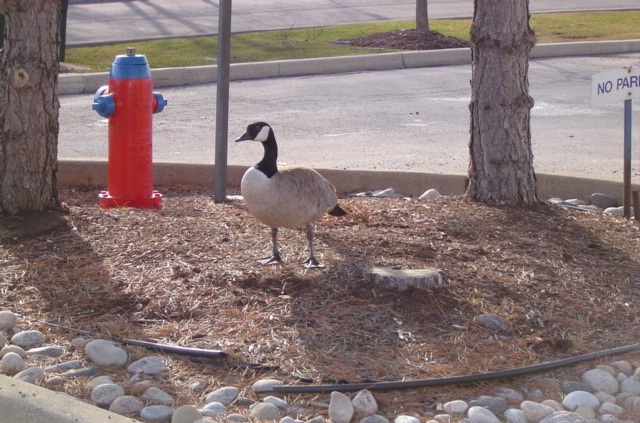Families of Canada geese occupying parks and crossing busy streets are an all too familiar sight in Kitchener-Waterloo and can cause for concern for area residents. Despite our familiarity with Canada geese, these birds aren’t well understood by the general public and that can sometimes lead to conflict. One of the most common issues related to Canada geese is when a flock interrupts traffic by walking across a busy thoroughfare.

Why do Canada Geese live in Cities?
Abundant Food
Canada Geese are primarily herbivores and love to graze on grass, particularly young shoots that can be found on freshly mowed lawns. Sports fields, golf courses, parks and campuses found in cities ensure Canada geese are always well fed.
Few Predators
Large expanses of grass not only provide Canada geese with food, they also help them avoid predators. Canada geese naturally avoid tall grasses, shrubs and bushes as they provide cover for predators. Geese therefore prefer to spend time in wide open expanses that allow them to see and evade predators well in advance. In rural areas, Canada geese populations are controlled in part by hunting but shooting a gun is banned in city limits.
Ideal Nesting Locations
Canada geese prefer to nest near bodies of fresh water. The Kitchener-Waterloo Region is dotted with numerous creeks, streams, lakes and marshes. These wetlands, both natural and manmade, make perfect nesting sites for Canada geese.
Canada Geese in Traffic
During spring and summer Canada geese can often be seen crossing busy roadways in single file with the goose (mother) at the front, the babies behind her and the father (gander) bring up the rear. When geese walk across roads they can slow traffic and potentially cause collisions. To help understand why geese choose to walk rather than fly it is important to understand their natural behaviour and life cycle.

As mentioned, geese are grazers and as a result they find their food by walking. They are very comfortable on their feet, walking great distances. Adult geese are big and strong and in urban environments there are few natural predators and so they feel safe walking over short distances as opposed to flying. Finally, geese in urban settings are comfortable with automobiles and traffic and aren’t necessarily scared to cross roads. In fact, it’s a valuable skill.
Another reason why geese walk is because their babies are not capable of flight until up to 10 weeks after birth. In Kitchener-Waterloo Region nesting begins in March. By mid-April the eggs have been laid and they will hatch 25-28 days later. The babies, known as goslings, can walk and swim almost immediately after birth and the entire family will often relocate up to several kilometres away from their nesting site to a brood-rearing location that includes grass and water. This trek is done entirely on foot and may involve crossing traffic. When a family of geese are crossing the road it is best to stay well back. Adult geese will aggressively defend their young and trying to help move them across the road could scatter the babies or scare the adults into oncoming traffic.
If you see a flock of geese in distress you need to consider your safety and that of other motorists first. You can help the flock by staying well back and alerting other motorists to the danger. Reporting the danger to MTO or police is your safest and best course of action.


